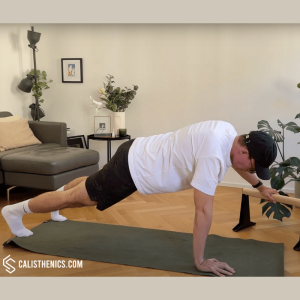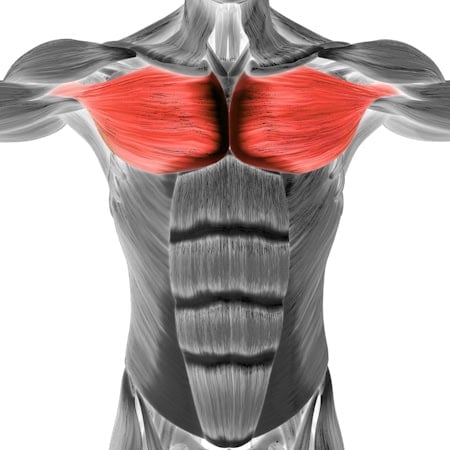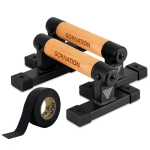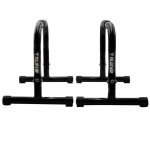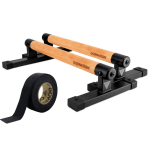Uneven Push-Ups
How to do Uneven Push-Ups?
Uneven push-ups are a variation of the standard push-up where one hand is elevated on a surface (like a ball, parallette, or stack of plates) while the other remains on the ground. This exercise creates an imbalance, requiring one side of the body to work harder, increasing the demand on the chest, shoulders, and triceps while challenging core stability and coordination. Uneven push-ups are highly effective for building unilateral strength, correcting muscle imbalances, and enhancing shoulder stability.
Steps to Perform a Proper Uneven Push-Up:
1. Set Up with an Elevated Surface:
• Place an elevated surface (such as a medicine ball, parallette, or small step) next to you.
• Get into a high plank position with one hand on the elevated surface and the other on the ground. Your hands should be shoulder-width apart.
2. Position Your Body:
• Keep your feet hip-width apart or slightly wider for balance.
• Your body should form a straight line from head to heels. Engage your core by pulling your belly button toward your spine to stabilize your torso.
3. Lower into the Push-Up:
• Inhale as you bend your elbows and lower your chest toward the floor, keeping your body in a straight line.
• Allow your shoulder on the elevated side to move slightly forward, and your elbow on the ground side should bend at about a 45-degree angle.
4. Press Back to the Starting Position:
• Exhale as you press through both hands to straighten your arms, returning to the starting position.
• Focus on keeping your core tight and your body aligned throughout the movement.
5. Switch Sides:
• After completing the desired number of repetitions, switch sides by placing your other hand on the elevated surface and repeat the movement.
Benefits of Uneven Push-Ups
• Builds Unilateral Strength: By using an uneven surface, this exercise develops unilateral strength and targets muscle imbalances in the chest, shoulders, and triceps.
• Improves Core Stability: The asymmetry of the uneven push-up increases the demand on the core muscles, enhancing overall core stability and balance.
• Enhances Shoulder Stability: Working with one hand elevated requires shoulder stability on both sides, improving the strength of stabilizing muscles and reducing injury risk.
• Increases Range of Motion: The elevated hand allows for a deeper stretch in the chest and shoulders, increasing the range of motion and improving flexibility.
• Great for Functional Strength: This exercise mimics real-life pushing patterns and promotes functional strength, which can improve performance in daily activities and sports.
• Accessible Without Equipment: Uneven push-ups can be performed using a variety of household objects, such as a stack of books, making them easy to incorporate into any workout routine.
Common Mistakes to Avoid
• Allowing Hips to Rotate: One of the most common mistakes is allowing the hips to rotate. Focus on keeping your hips level and your core engaged to prevent twisting.
• Sagging in the Lower Back: Keep your core tight to prevent your lower back from sagging. This helps protect your spine and ensures proper alignment.
• Overextending the Elevated Arm: Avoid placing your elevated hand too far out to the side, which can put unnecessary strain on your shoulder. Keep your hand aligned under your shoulder.
• Using Momentum: Avoid rushing the movement or using momentum to push yourself up. Focus on slow, controlled movements to engage the correct muscles.
• Uneven Weight Distribution: Ensure that both sides are actively engaged. Avoid shifting all the weight onto the grounded arm; both arms should be working in harmony.
Tips for the proper execution of Uneven Push-Ups
Engage Your Core: Keep your core tight to prevent your hips from sagging or rotating as you lower and press back up.
Focus on Form: Perform the movement slowly and with control to maintain proper alignment and avoid using momentum.
Maintain a Straight Line: Keep your body in a straight line from head to heels, avoiding any arching or rounding of the back.
Controlled Breathing: Inhale as you lower into the push-up and exhale as you press back up. Steady breathing helps maintain rhythm and core stability.
Muscles worked when doing Uneven Push-Ups
Primary Muscles:
•Pectoral Muscles (Chest): The uneven surface intensifies the engagement of the chest, especially on the side of the elevated hand.
•Triceps: The triceps work to extend the elbows and stabilize the arms during the push-up, especially on the side of the grounded hand.
•Deltoids (Shoulders): The shoulder muscles work to stabilize and control the movement, especially with the asymmetry created by the elevated hand.
Secondary Muscles:
•Core: The abdominals and obliques stabilize the torso, helping to maintain alignment and balance throughout the movement.
•Forearms: Assist in stabilizing the wrist and forearm on the elevated side, especially if using an unstable surface like a ball.
•Lower Back: The erector spinae muscles work to maintain a neutral spine and prevent sagging of the lower back.
•Glutes and Legs: Engage to help stabilize the lower body and maintain full-body alignment during the push-up.
Primary Muscle(s):
Secondary Muscle(s):
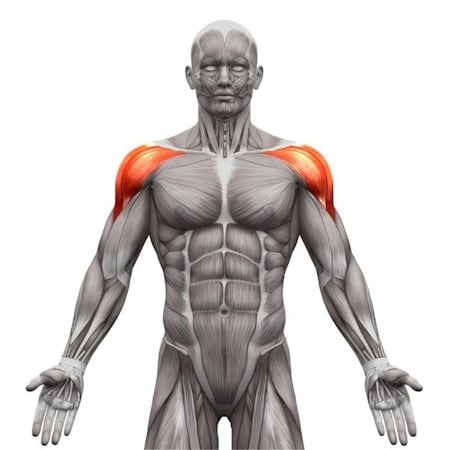
Anterior delt
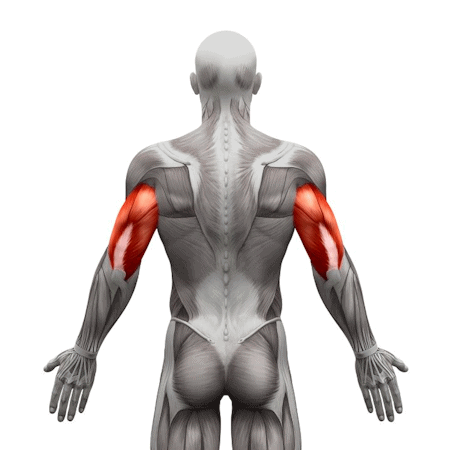
Triceps
Adjust the difficulty of Uneven Push-Ups
How to make Uneven Push-Ups harder?
How to make Uneven Push-Ups easier?
How to make Uneven Push-Ups harder?
To make Uneven Push-Ups harder:
-
Use an Unstable Surface: Place your elevated hand on an unstable surface, such as a medicine ball or balance pad, to increase the stability challenge and intensify core engagement.
-
Increase Elevation Height: Use a higher elevated surface (like a box or a higher parallette) to increase the intensity on the lower side, making the movement more challenging for the chest and shoulders.
-
Add Resistance: Wear a weighted vest or place a weight plate on your back to increase the load, making the exercise more challenging for your upper body.
-
Increase Repetitions or Sets: Perform additional repetitions or sets on each side to further challenge your endurance and strength.
How to make Uneven Push-Ups easier?
To make Uneven Push-Ups easier:
-
Use a Lower Elevated Surface: Start with a lower elevation, such as a thick book or small step, to reduce the intensity and allow for more control.
-
Perform on the Knees: Perform the push-up with your knees on the ground to decrease the load on your upper body and core, making it easier to maintain proper form.
-
Limit Range of Motion: Lower only partway down instead of going all the way to the floor, gradually increasing the depth as your strength improves.

